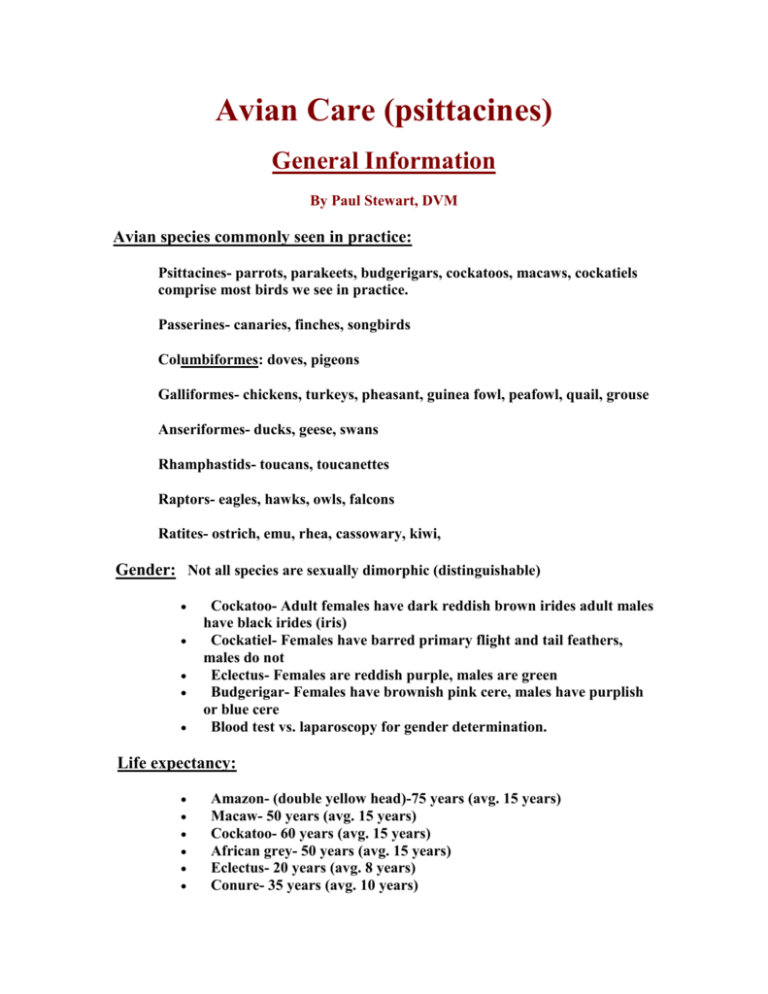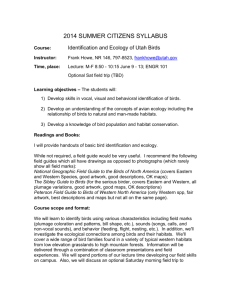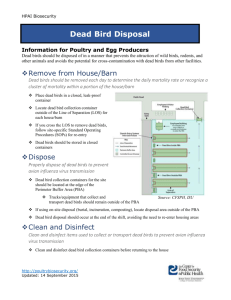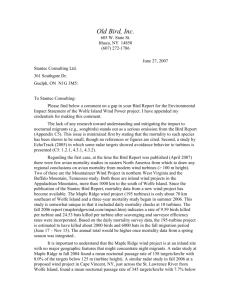Avian Care - Avian and Exotic Pet Clinic of Roanoke
advertisement

Avian Care (psittacines) General Information By Paul Stewart, DVM Avian species commonly seen in practice: Psittacines- parrots, parakeets, budgerigars, cockatoos, macaws, cockatiels comprise most birds we see in practice. Passerines- canaries, finches, songbirds Columbiformes: doves, pigeons Galliformes- chickens, turkeys, pheasant, guinea fowl, peafowl, quail, grouse Anseriformes- ducks, geese, swans Rhamphastids- toucans, toucanettes Raptors- eagles, hawks, owls, falcons Ratites- ostrich, emu, rhea, cassowary, kiwi, Gender: Not all species are sexually dimorphic (distinguishable) Cockatoo- Adult females have dark reddish brown irides adult males have black irides (iris) Cockatiel- Females have barred primary flight and tail feathers, males do not Eclectus- Females are reddish purple, males are green Budgerigar- Females have brownish pink cere, males have purplish or blue cere Blood test vs. laparoscopy for gender determination. Life expectancy: Amazon- (double yellow head)-75 years (avg. 15 years) Macaw- 50 years (avg. 15 years) Cockatoo- 60 years (avg. 15 years) African grey- 50 years (avg. 15 years) Eclectus- 20 years (avg. 8 years) Conure- 35 years (avg. 10 years) Lories and lovebirds- 12 years (avg. 4 years) Cockatiels- 30 years (avg. 6 years) Budgerigars- 18 years (avg. 6 years) Duck- 10-15 years Goose- 15-20 years Ostrich-80 years Emu- 30 years Purchasing a bird (read, read, read!!!) Novice: Cockatiel, Budgie, Lovebird, Zebra Finch, Intermediate: Quaker, Senegal, Pionus, Conure, Amazon Advanced: African grey, Amazon, cockatoo, macaw Garden variety is recommended as in dogs and cats. Weaned hand-raised babies direct from breeder are recommended. Contact the Roanoke Valley Bird Club (RVBC)-Sue Brewer Talking ability: African Grey > Amazon > Budgie > Cockatoo > Cockatiel > Conure > Macaw> Husbandry Caging and shelter requirements: Must be approved for birds Must contain no toxic materials Be escape proof Be injury proof Have adequate room for exercise Be easy to clean Perch Requirements: Proper-size and type of perch (sandpaper perches are not recommended) Diameter should be equal to length of longest toe Diameter and texture should vary to some degree Position not to contaminate food or water, or prevent exercise Nest box or hide box: Need for security Substrate: Newspaper, crushed walnut shells/corn cob, Yesterdays News Should be inaccessible to the bird Lighting Requirements: Full spectrum florescent tubes (changed every 6 months) Vitalite Be on timer with day length set according to species need for seasonal change. Protected outdoor enclosure with access to direct sunlight and shade Temperature: To mimic natural environment of species kept Most species do well at 70-80 degrees F Humidity: To mimic natural environment of species kept Tropical species: 75-85% Arid species: 60-70% Humidifiers- cool air vs. warm air Ventilation: Twelve room exchanges per hour optimum Water: (changed daily, bowl disinfected regularly) Covered water dishes Sipper bowls Bottles Grooming: Bird baths Misting Shower time Nail trimming/grinding Wing trimming Beak grinding Exercise and handling: Keep food and water at opposite ends of the cage Daily playtime, training Exercise gym Controlled flight Socialization and behavior: Expose early in life to novel events (car rides, restraint, multiple handlers, nail and wing trims, other pets Daily routine with training sessions (use only positive re-enforcement) Encourage student-teacher relationship always Why use a towel for restraint? Safer and less fear of human hands Environmental enrichment: Cage toys should be rotated weekly and should encourage climbing, exploring, chewing, thinking Mirrors are not recommended unless human interaction is not a goal. Dangers of the household Ceiling fans, house pets, boiling water, Teflon pans, cigarette smoke, chocolate, caffeine, alcohol, salt, avocado toxic fumes, sprays chemicals, medications, houseplants, heavy metals Know your birds environment Never leave unattended Psittacine Nutrition As a general rule, A well balanced organic formula (like Harrison’s Bird Diet) as the foundation, with a daily variety of fresh vegetables, fruits, cereals, grains and occasional seeds and nuts Never change diets abruptly as birds may starve themselves or get G.I. upset. It is important to weigh the bird regularly while changing diets to make sure he or she is not losing significant weight. -Below are some general guidelines to help with feeding Harrison’s bird diets: 1) 2) 3) 4) 5) 6) Coarse grind for larger birds (Macaws, Cockatoos, Amazons, Eclectus, African Greys, Pionus, Senegals Fine grind for Quakers, Cockatiels, Lovebirds, Budgies, Parrotlets, Doves, Pigeons. Mash for Passerines (Canaries, Finches) High Potency Formula: for birds that are growing, breeding and moulting Adult Lifetime Formula: for adult birds that are not ill, moulting or reproducing. The amount to feed can be found in the Harrison’s brochure, but may vary according to the individual. Supplement the feeding formula with a mixture of chopped fresh or steamed vegetables from the following list: broccoli, carrot, squash, sweet potato, bell pepper, beans, peas, alfalfa sprouts, tofu, cauliflower, occasional greens, Fresh vegetables and fruit should be fed in a separate dish and remain in the cage for no longer than 6 hours, as they will spoil. 5% or less of the diet can consist of snack food items such as corn, pizza, cheese, meats, spagetti, low fat popcorn, Doritos. Calcium supplement can be offered to those in need in the form of calcium carbonate (ground oyster shell) Vitamin supplements added to the water should be avoided and are only recommended in birds with a poor diet or appropriate medical condition. In those cases, the supplement should be the type that can be added to the food. Grit is not necessary for psittacine birds, and only minimally necessary for passerines and galliformes. What we offer at the Avian and Exotic Pet Clinic: Therapeutic and preventative medicine Vaccination Surgery Radiology Dentistry Ultrasound Endoscopy Lab services (In-house and specialty services) Consultation (behavior and husbandry) Nail trimming, Wing trimming Beak trimming (cosmetic and corrective) and polishing Mat removal and trimming Bathing Boarding (for treatment) Hospitalization and intensive care Humane euthanasia, cremation services and grief counseling Emergency service The Avian Background Sheet See the hospital forms section of the website to download these forms to fill in before your office consultation. Weighing: (in the exam room) (in grams) 1 kg=1000 grams Macaws-pediatric scale Smaller birds- gram scale Clean hand towel for small birds Larger towel for larger birds The Avian Life Cycle Consultation and Exam Diet history Environmental history Medical history Comprehensive physical exam: skin, plumage, nails, eyes, ears, nose, throat, oral cavity, musculo- skeletal system, digestive system, genitourinary system, cardiovascular system, respiratory system, weight Recommend appropriate testing if needed: fecal (direct, flotation, trichrome), cultures, blood chemistry, protein electrophoresis, CBC/differential, Serology/PCR, radiographs Behavior Husbandry Diet Gender testing Avid microchip vs. band Psittacosis (Chlamydophila) testing Grooming Take-home sheets (includes toxic substance sheet, psittacosis info, HBD handout +/- sample, “signs of a sick bird”) +/- Medications






